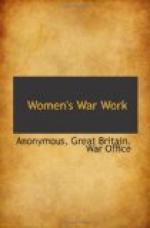The London Society for Women’s Suffrage, which was running “Women’s Service,” had women volunteers for munitions in enormous numbers and tried to secure openings for them. It investigated and found that acetylene welders were badly needed. There were very few in Britain, and welding is essential for aircraft and other work, so they started to find out if there were classes for training women, and found none in Technical Schools were open to women. They found welders were needed very much in certain aircraft factories in the neighborhood of London and the manager of one assured them that if women were trained satisfactorily for oxy-acetylene welding, he would give them a trial. So “Women’s Service” decided to open a small workshop and secured Miss E.C. Woodward, a metal worker of long standing, as instructor. The school was started in a small way with six pupils. Oxy-acetylene welding is the most effective way of securing a perfect weld without any deleterious effect upon the metal.
The great heat needed for the purpose of uniting two or more pieces of metal so as to make of them an autogenous whole is obtained, in this process, by the burning of acetylene gas in conjunction with oxygen.
Carbide, looking like little lumps of granite, is placed in a tray at the bottom of the generator for acetylene gas, which is of the form of a small portable gasometer. The tap, admitting water to the carbide trays, is turned on, and gas at once generates, and forces up the generator in the way so familiar to those who often see a gasometer. This gas passes through a tube to the blow-pipe of the welder, or to any other use for which it is destined.
[Illustration: Training women as aeroplane builders]
In oxy-acetylene welding, the process employs the flame produced by the combustion in a suitable blow-pipe of oxygen and acetylene. When a light is applied to the nozzle of the pipe a yellow flame, a foot long, flares up, and in the centre of it, close to the nozzle, appears a very small, dazzling, bluish flame, which can only safely be gazed upon by eyes protected by coloured glasses. The temperature of this flame at the apex is about 6,300 degrees Fahr., and it is with this that the metals to be welded together are brought to a suitable degree of heat.
The workers’ eyes are protected by black goggles, their hair confined by caps or handkerchiefs, and overalls or leather-aprons protect their clothes from the sparks and also from the smuts which naturally accrue on surrounding objects. Each welder holds in her right hand the blow-pipe of the craft, from which depends two long flexible tubes, one conducting oxygen from the tall cylinder in the corner, and the other acetylene from the generator. In her left hand she holds the welding-stick of soft Swedish iron, from which tiny molten drops fall upon the glowing edges of the metal to be welded together. The work is fascinating even to the onlooker, and to see the result, metal so welded you feel it is impossible it ever could have been two pieces, is still more fascinating.




